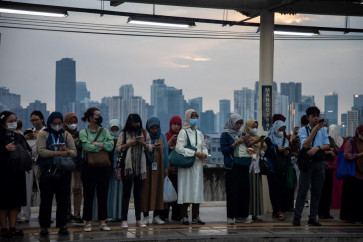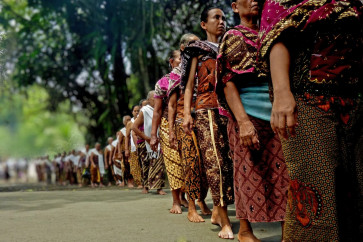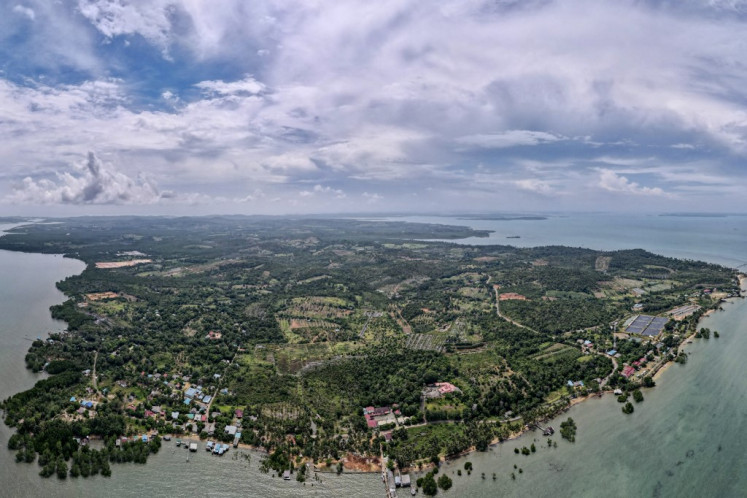Popular Reads
Top Results
Can't find what you're looking for?
View all search resultsPopular Reads
Top Results
Can't find what you're looking for?
View all search resultsThe metamorphosis of 'wayang beber'
Ghostly: This image of part of a wayang beber scroll features Rama preparing for battle
Change text size
Gift Premium Articles
to Anyone
Ghostly: This image of part of a wayang beber scroll features Rama preparing for battle.
While wayang kulit, or leather puppet shows, remain popular, wayang beber, a scroll-painted version of narration, has become a rarity, even in the cities known as the last bastions of this art: Pacitan in East Java and Wonosari in Gunung Kidul, Yogyakarta.
Wayang beber uses a cambric scroll as its medium, with illustrations of characters and scenes of the story to be told. The scroll is stretched between two columns, with the unrolled part being narrated by a dalang (puppeteer or narrator).
The episodes recited are generally derived from the romances of Panji (Prince) Asmarabangun and Dewi (Princess) Sekartaji in the history-based legends of East Java kingdoms around the 12th century.
'A dalang tells the story to his audience while unrolling the scroll. Now this wayang genre very rarely appears, not only in Solo but also in its original areas,' said Dani Iswardana, a contemporary wayang beber painter from Solo.
As a branch of performing arts and fine arts, wayang beber has practically come to a standstill. Some of the old scrolls left are now even kept by individuals as artifacts.
'The art was most frequently staged long ago. Existing since the 1200s, it's much older than wayang kulit,' Dani said.
Lengthy: A visitor passes a wayang beber work by senior artist Djoko Sri Yono at a recent exhibition in Solo.
A wayang beber was recently performed by Ki Supani at the Sudjatmoko Center in Surakarta. Rather than a main program, the show by the dalang from Pacitan enlivened the opening of a wayang beber exhibition, 'Between Inspiration and Transformation'. The display positioned wayang beber paintings as works of art even as they are used on stage for performances.
About 50 scrolls painted by artists of different generations from Solo and Yogyakarta were exhibited, including those by Djoko Sri Yono, Pudjianto and Hermin Istiariningsih, known as classical wayang beber painters. Their strokes and lines follow the sungging (intricate design painting) technique, covering traditional compositions and details.
Djoko Sri Yono presented his Panji illustrations depicting the episode of King Klana disguising himself as Gandarepa in an attempt to grab Dewi Sekartaji.
He used colors typical of wayang beber, brown, yellow and bright green. Younger artists experimented with non-standard patterns.
Dani Iswardana introduced what he termed wayang beber kota (city-styled), distinguishing his from the classical stories. In the style of this Solo artist, it is not the Panji episodes that are his focus but the lives of those on the margins and their difficulties. While retaining the shape of wayang characters, the stories have leaped into the present.
One can see Limbuk, a female clown, on Dani's scroll being upset by a major flood as a result of gutters littered with garbage. More interestingly, the lead character, Dewi Sekartaji, can be seen hysterical in the face of soaring red onion prices.
Apart from Dani, other young painters tried to approach classical or established wayang beber as a source of inspiration.
Different: The style of wayang beber hails from Wonosari in Gunung Kidul and features the story of Kyai Remeng Mangunjaya.
Terra Bajraghosa in Quest for the Golden Scrolls also 'betrayed' the standard episodes. Instead of portraying the Panji-Dewi romances, the Yogyakarta artist made a mini comic about a girl having an adventure on a robotic bicycle.
Slamet Riadi's Ditarik Aja in Just Stretch It deconstructs classical wayang kulit characters into new forms: Chinese figures with a temple-roofed building rather than the symbolic mountain or gunungan. Under the figures is a dalang in a costume worn by a wayang potehi (Chinese wooden puppet) player.
There were also episodes of the Hindu epics as well as local legends such as Calon Arang (by Bagyo Suharyono), Tipu Muslihat Rahwana (Rahwana's Deception by Aklis Nuryadin) and Perjalanan Cindelaras (Cindelaras' Journey by Sutopo).
In the hands of Joko Wiyono, wayang beber turned critical. His work Bersaing Berebut (Competing in a Scramble) alludes to greed and the power-thirsty political elite. He calls to mind the Javanese saying, rebutan balung tanpa isi, meaning struggling for something worthless.
Another item on display came from the story of Joko Kembang Kuning, rendered by Sutopo. This tale is famous for being widely believed as the final part of the genuine wayang beber story of Pacitan. According to the standard, the final scene must never be narrated. Consequently, with its 24 scenes, the narration will stop when it comes to the 24th.
'Nobody knows the reason for it. But it's likely that the last one describes the atmosphere of fervent affection between Panji Asmarabangun and Dewi Sekartaji so that it's seen as inappropriate for public description,' Joko Sri Yono said.
New: This contemporary wayang beber by Terra Brajaghosa is titled Quest for the Golden Scrolls.
The exhibition also had two reproductions of wayang beber scrolls from Wonosari and Pacitan. The original scrolls from which the exhibits were reproduced are considered sacred. The families that own the antiques won't allow anybody to view the actual scrolls. If they are to be shown, special rituals are
required.
In Pacitan, many people refer to Ki Sarnen Gunocarito as the 12th-generation dalang of genuine wayang beber called Joko Kembang Kuning. Ki was succeeded by Ki Sumardi. But sadly, the two highly skilled narrators have passed away.
Today Ki Supani has appeared as the 14th-generation dalang because he is the grandson of Ki Sarnen and the son of Ki Sumardi. However, Ki Supani isn't yet an expert in performing classical wayang beber.
'I've become a dalang as an inheritor of this wayang beber handed down through generations. I still have to learn a lot more so as to be as skillful as my grandfather and father,' he said after his show at the Sudjatmoko Center.
In Wonosari, the wayang scroll is named Wayang Beber Kyai Remeng Mangunjaya. Its owner, Ki Sipar, is the seventh-generation narrator of Kyai Remeng Mangunjaya.
Wayang beber is indeed getting very scarce, so that the display is expected to lead to a revival of one of the country's regional folk arts. Nevertheless, this event has provided some relief as it seems to have proven that quite a number of contemporary artists never abandon traditional arts.
These artists have contributed their works in accordance with the era in which they live and grow. At least in the styles of Terra Brajaghosa, Samet Riadi, Nasirun, Herdjaka, Dani Iswardana and Aklis Nuryadin, wayang beber has metamorphosed into its new forms.
'Times have changed, but at least there are many artists who continue to be loyal to traditional roots although their works have developed to a further extent,' concluded Dani.
' Photos By Ganug Nugroho Adi













